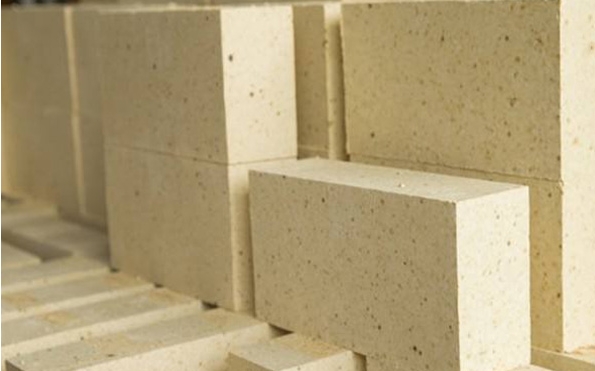- 14
- Sep
Вторична тухла с висок алуминий
Вторична тухла с висок алуминий

High alumina bricks are made of high alumina bauxite as the main raw material, mixed with soft raw clay as a binding agent, and then formed and fired at a high temperature of about 1500°C. According to the content of Al2O3, it is divided into three grades: those with Al2O3 content greater than 75% are first-level high-alumina bricks, those with Al2O3 content between 60% and 75% are second-level high-alumina bricks, and those with Al2O3 content between 48% and 60% are Three-level тухла с високо съдържание на алуминий. Its load softening temperature is not less than 1400~1530℃. Compared with clay bricks, high alumina bricks have the outstanding advantages of high refractoriness and load softening temperature. With the increase of Al2O3 content, the slag resistance performance is significantly improved.
1. Refractoriness
The refractoriness of high alumina bricks is higher than that of clay bricks and semi-silica bricks, reaching 1750~1790℃, which belongs to advanced refractory materials. The refractoriness is mainly affected by the content, type and quantity of Al2O3, and the refractoriness increases as the content of Al2O3 increases.
2. Load softening temperature
Because high alumina bricks have high Al2O3, less impurities, and less fusible glass bodies, the load softening temperature is higher than that of clay bricks. However, because mullite crystals do not form a network structure, the load softening temperature is still not as high as that of silica bricks.
3. Топлопроводимост
High alumina bricks have better thermal conductivity than clay bricks. The reason is that there are fewer glass phases with low thermal conductivity in high-alumina products, while the number of mullite and corundum crystals with better thermal conductivity increases, which improves the thermal conductivity of the product.
4. устойчивост на топлинен удар
The thermal shock resistance of high alumina bricks is between clay products and siliceous products. The water cooling cycle at 850°C is only 3 to 5 times. This is mainly due to the fact that corundum has higher thermal expansion than mullite without crystal transformation. At present, it is possible to improve the product’s particle structure, reduce the content of fine powder, and increase the critical particle size and particle gradation of the clinker to improve the thermal shock resistance of the product.
5. Устойчивост на шлака
High alumina bricks have more Al2O3, which is close to neutral refractory materials, and can resist the erosion of acidic slag and alkaline slag. Because of the inclusion of SiO2, the ability to resist alkaline slag is weaker than that of acidic slag. In addition, the slag resistance of high alumina bricks is also related to the stability of the product in the slag. Generally speaking, after high-pressure molding and high-temperature firing, products with lower porosity have higher slag resistance.
6. The parameters of high-alumina bricks vary widely, and their physical properties should be determined according to the grade of the product and the place of use when in use. At present, the general high alumina brick standard GB2988-88 is generally adopted. If you need to use super high alumina bricks, please refer to GB/T 2988-2012 standard physical and chemical indicators. The index of high alumina brick is the basic performance requirement. According to the conditions of use, creep resistance and thermal shock resistance should also be considered. The chemical resistance directly depends on the A12O3 content and porosity.
7. When firing secondary high-alumina refractory bricks, the general firing temperature is 1350~1450℃, and the heat preservation is 40h. When firing the third-grade high-alumina refractory bricks, the firing temperature is 1300-1350℃, and the heat preservation is 24h~32h. If the tunnel kiln is used to fire the first and second grade aluminum refractory bricks, the firing temperature is usually 1500~1560℃. From the physical and chemical index chart, we can see that the secondary high alumina brick is a medium product in the high alumina brick series, with a bulk density of 2.4g/cm3, which can withstand a flame temperature of 1770°C.
8. Physical and chemical indicators:
| Ранг/индекс | Тухла с високо съдържание на алуминий | Вторична тухла с висок алуминий | Тристепенна тухла с висок алуминий | Супер тухла с алуминиев оксид |
| LZ-75 | LZ-65 | LZ-55 | LZ-80 | |
| AL203 ≧ | 75 | 65 | 55 | 80 |
| Fe203% | 2.5 | 2.5 | 2.6 | 2.0 |
| Обемна плътност g / cm2 | 2.5 | 2.4 | 2.2 | 2.7 |
| Якост на натиск при стайна температура MPa> | 70 | 60 | 50 | 80 |
| Заредете температурата на омекотяване ° C | 1520 | 1480 | 1420 | 1530 |
| Огнеупорна температура ° C> | 1790 | 1770 | 1770 | 1790 |
| Явна порьозност% | 24 | 24 | 26 | 22 |
| Процент на смяна на постоянна линия на отопление% | -0.3 | -0.4 | -0.4 | -0.2 |
